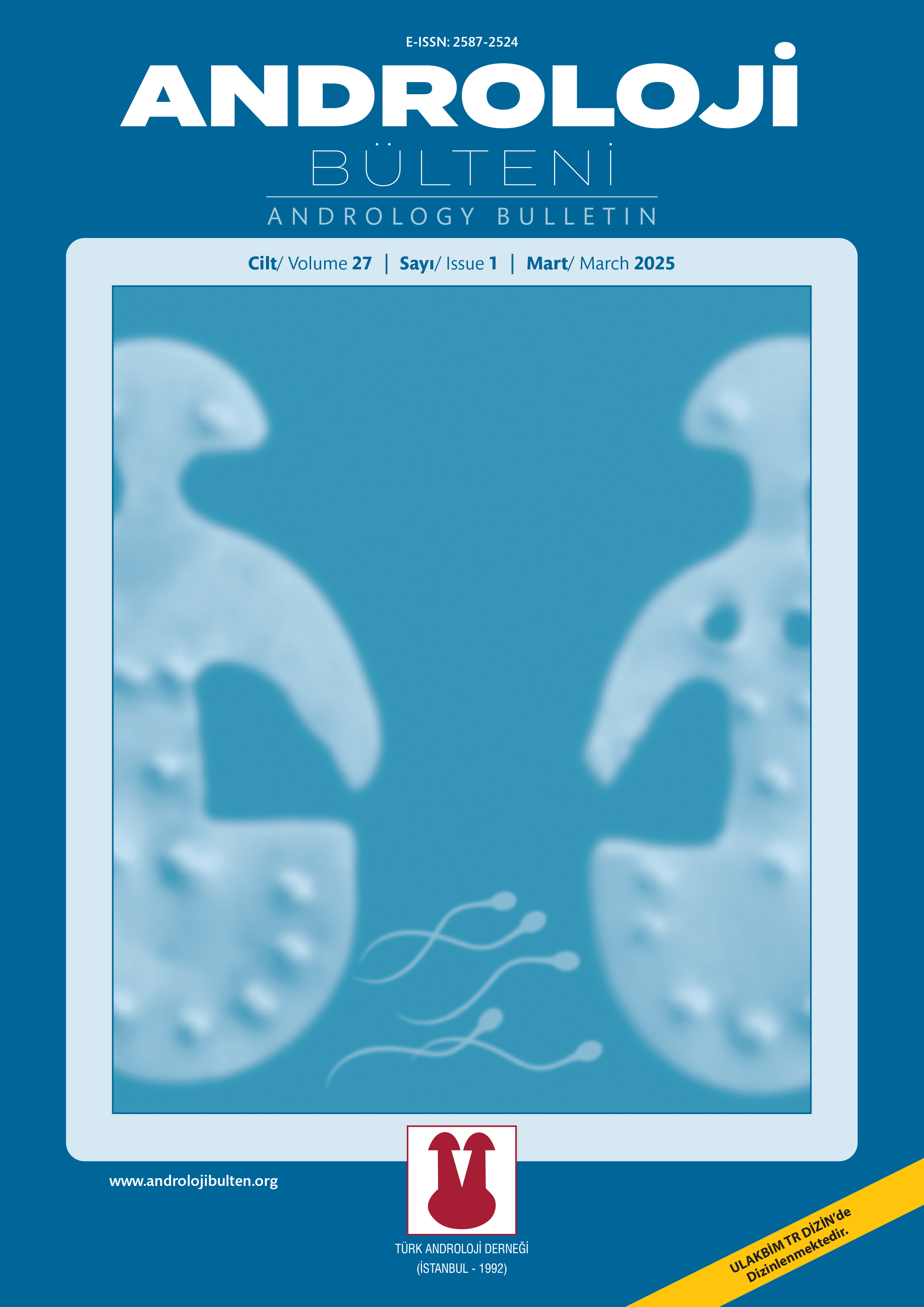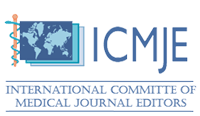INDEXES

Content of this journal is licensed under a Creative Commons Attribution-NonCommercial 4.0 International License.
Volume: 23 Issue: 2 - 2021
| 1. | Cover Page I |
| 2. | Reviewers Pages II - III |
| 3. | From the President Page IV |
| 4. | From the Editor Page V |
| 5. | Contents Page VI |
| ORIGINAL ARTICLE | |
| 6. | Lifestyle behaviors of infertile and fertile women Gözde Bektaş, Hatice Kahyaoğlu Süt doi: 10.24898/tandro.2021.34392 Pages 67 - 76 OBJECTIVE: In the study, it is aimed to evaluate the lifestyle behaviors of infertile and fertile women comparatively. MATRERIAL and METHODS: This cross-sectional study was conducted between October 2016 and December 2017 in a State University Hospital Gynecology Outpatient Clinic and Assisted Reproductive Techniques Center. The study was conducted comparatively on a total of 304 women, n=152 infertile and n=152 fertile women, who applied to the hospital. The data were collected using the information forms prepared by examining the literature and the Perceived Stress Scale (PSS). RESULTS: It was found that the marriage age of infertile women was higher than fertile women (p=0.010). It was found that among infertile women, those who were physically active did one to two more physical activities per week (p=0.046). It was determined that the number of women who began drinking alcohol between the ages of 19–25 was higher in the infertile women (p=0.027). It was found that the infertile women used wi-fi connected computers more (p=0.021), and the frequency of using computers during the day was six-eight hours the most (p=0.004). The rate of having an infection in the fallopian tube of the infertile women was found to be higher with compared to the fertile women (p<0.001). Infertile women also have significantly higher mean PSS scores (p=0.001). CONCLUSION: Infertile women are later in marriage than fertile women, alcohol consumption at the beginning of reproductive age and more hours of computer use with Wi-Fi connection during the day. Infertile women have a higher rate of infection through their fallopian tubes and their perceived stress level is higher. Lifestyle behaviors training should be given to women of infertile by health professionals and nurses to protect fertility. |
| 7. | What are the effects of complete blood counts and glycemia on sperm retrieval in micro-TESE procedure? Bahadır Topuz, Turgay Ebiloğlu, Selçuk Sarıkaya, Engin Kaya, Adem Emrah Coğuplugil, Selahattin Bedir doi: 10.24898/tandro.2021.36043 Pages 77 - 81 OBJECTIVE: To study the prognostic significance of some complete blood counts parameters and serum glucose level in predicting the presence of sperm in microsurgical testicular sperm extraction (micro- TESE) procedure. MATRERIAL and METHODS: The data of 56 patients who underwent micro- TESE procedure due to non-obstructive azoospermia (NOA) between January 2017 and March 2020 were retrospectively analyzed. The data of the patients included in the pre-anesthesia evaluation were recorded. Complete blood count parameters, serum inflammation markers obtained by the ratio of these parameters (neutrophil/lymphocyte ratio, platelet/ lymphocyte ratio) and serum fasting glucose levels were examined. RESULTS: The mean age of patients was 33.28±4.4 (22–44) years. Our total sperm retrieval rate was 55.4% (n: 31). When the effect of complete blood count parameters and glycemia on sperm retrieval in micro-TESE procedure was examined, only the white blood cell, platelet, neutrophil and monocyte count were found to be statistically significant (respectively, p=0.03; p=0.04; p=0.008; p=0.007) CONCLUSION: According to our study, we showed that neutrophil/ lymphocyte ratio and platelet/lymphocyte ratio, which are markers of systemic inflammation, do not predict sperm retrieval in micro-TESE. We found that the levels of white blood cells and neutrophils, which are inflammatory cells, were statistically higher in the sperm-presence group. We have also shown that serum glucose level does not affect sperm retrieval. |
| 8. | Intrauterine insemination experience of a university hospital: Pregnancy rate and associated factors Erhan Ateş, Abdullah Akdağ, Arif Kol, Özgür Deniz Turan, Haluk Erol doi: 10.24898/tandro.2021.85619 Pages 82 - 86 OBJECTIVE: Intrauterine insemination (IUI) is considered as the first choice treatment method because it is cheaper, easily applicable and less invasive compared to other assisted reproductive techniques. The specific objective of this study was to evaluate the IUI results and to reveal the male factors affecting success in a university hospital infertility unit. MATRERIAL and METHODS: The data of the couples who applied to the infertility unit between October 2017 and January 2020 and underwent IUI were retrospectively evaluated. Semen analysis results such as initial total sperm count, progressive motile sperm percentage, post-washing TMSC and percentage, and ages of patients were recorded. To identify IUI success the following parameters were used: Patients whose ß-hCG test was positive after single insemination with sperm prepared by density gradient centrifugation and whose pregnancy was confirmed by transvaginal USG. Relationship between semen parameters and pregnancy success rates was evaluated using appropriate statistical methods. RESULTS: Clinical pregnancy rate was 19.2% in 146 couples who underwent IUI, 19.9% in 136 couples whose data were complete. Mean age of 136 men was 30.34±5.94 years. Although there was no significant relationship between age and IUI success, it was observed that the success rate decreased as age increased (p=0.316). No statistically significant correlation was found between semen volume (p=0.228), TMSC before washing (p=0.187), progressive motile sperm before washing (p=0.128) and pregnancy rates. It was observed that as the percentage of progressive motile sperm after washing increased, the pregnancy rate increased significantly (p=0.04), but this relationship was not found with the total motile sperm count after washing (p=0.143). There was a correlation between initial progressive motile sperm count and sperm count after washing (r: 0.286, p<0.001). CONCLUSION: In the treatment of unexplained infertility cases, IUI is an effective and safe method for pregnancy. Semen parameters before insemination and after washing are among the factors affecting success rates. |
| 9. | Association between female sexual dysfunction and polycystic ovary syndrome Engin Kölükçü, Fikret Erdemir, Selim Gülücü, Mehmet Yılmaz doi: 10.24898/tandro.2021.15045 Pages 87 - 96 OBJECTIVE: This study aimed to analyze the importance of polycystic ovary syndrome (PCOS) in female sexual dysfunction. MATRERIAL and METHODS: A total of 60 women of reproductive age with the diagnosis of PCOS were evaluated prospectively. Cases; were randomized into two groups as healthy volunteers (Group 1, n: 30) and women with PCOS (Group 2, n: 30). Demographic characteristics, body mass index (BMI), waist circumference, modified Ferriman Gallwey (mFG) scores and biochemical parameters of the participants were evaluated. Scores of the Female Sexual Function Index (FSFI), Rosenberg Self-Esteem Scale (RSES), Beck Anxiety Inventory (BAI), and Beck Depression Inventory (BDI) were calculated for each case included in the study. RESULTS: The patients’ mean age was 25.95±3.31 years, which was similar for both groups (p: 0.734). BMI, waist circumference, and mFG score were significantly higher in Group 2 (p: 0.008, p: 0.006, and p<0.001, respectively). Similarly, RSES, BAI, and BDI were quite high in Group 2 (p<0.001, p: 0.003, and p: 0.005, respectively). Hyperandrogenism findings were observed predominantly in the hormone panels of the patients in Group 2, and disorders in the lipid profile and insulin metabolism were also detected (p<0.05). The average total FSFI score was 22.81±6.46 in Group 2, which was lower than Group 1 (p: 0.047). There was a moderate and highly significant negative correlation between the FSFI scores and BMI, waist circumference, mFG, RSES, BAI, BDI, Insulin Resistance Index (HOMAIR), and dehydroepiandrosterone (DHEA-S) levels in Group 2 (p<0.001). Similarly, the deteriorated lipid profile and sexual scores were negatively affected (p<0.05). CONCLUSION: In our study, a close relationship was observed between PCOS and female sexual dysfunction. Accordingly, we think that it is extremely important to consider PCOS which is seen less frequently in addition to common causes in the etiology of patients presenting with female sexual dysfunction. |
| 10. | Investigation of the university female students knowledge on the HPV (Sakarya, Turkey) Kevser Özdemir, Sevil Şahin, Alaettin Ünsal doi: 10.24898/tandro.2021.24540 Pages 97 - 104 OBJECTIVE: To determine the level of knowledge of university students about HPV. MATRERIAL and METHODS: The study is a cross-sectional study conducted on Sakarya University students between September- November 2015. The study group consisted of 618 female students who agreed to participate in the study and were in the school during the study. Mann-Whitney U test, Kruskal-Wallis test and Spearman’s Correlation Analysis were used for the analyses. The statistical significance level was accepted as p<0.05. RESULTS: The age of the study group ranged from 18 to 30, with a mean of 20.21±1.77 years. In this study, the most commonly known information question about HPV was “Unhygienic procedures increase the risk of HPV transmission in the genital area”, while the most commonly misknown was “HPV infection does not directly affect fertility” information question. The scores that students got from knowledge questions about HPV ranged from 0 to 28, and the mean was 8.43±7.37. CONCLUSION: In this study, it was seen that students’ knowledge level about HPV was low. There is no relationship between students’ academic grade averages and HPV knowledge levels. It may be useful to include health-related courses in universities and to provide information about HPV in these courses. Also, informing about the HPV periodically will increase the sensitivity and awareness on this issue. |
| 11. | Can varicocelectomy be a treatment option in premature ejaculation? Hasan Turgut, Mehmet Ali Karagöz doi: 10.24898/tandro.2021.02360 Pages 105 - 108 OBJECTIVE: Premature ejaculation is one of the most common sexual dysfunction in men. Premature ejaculation can often be seen in patients with clinical varicocele. In our study, we investigated the effect of varicocelectomy on premature ejaculation MATRERIAL and METHODS: Between October 2018 and March 2020, patients with premature ejaculation who were operated for clinical varicocele were enrolled in the study, prospectively. Microscopic subinguinal varicocelectomy was performed in all patients. The data of the Turkish validated form of the Premature Ejaculation Diagnostic Tool (PEDT) and intravaginal ejaculatory latency time (IELT) were recorded before and 6 months after the procedure and compared. RESULTS: A total of 64 patients were included in the study. While the mean IELT duration of the patients before surgery was 32.4 ± 4.2, this duration increased to 134.6 ± 17.3 seconds in the postoperative 6th months, the difference was found to be statistically significant (p<0.001). When the PEDT scores were evaluated, it was determined that while it was 14.2 ± 4.8 before the procedure, this value decreased to 6.68 ± 3.2 after the procedure and there was a statistically significant difference in this value. (p<0.001). CONCLUSION: In this study a significant improvement was determined in ejaculatory time after varicocelectomy in patients with premature ejaculation with clinical varicocele. Varicocelectomy, can be offered in the treatment of premature ejaculation in appropriate indications, along with pharmacological and behavioral therapy |
| REVIEW | |
| 12. | Management of sexual dysfunctions in prostatitis Abdullah Açıkgöz, Fikret Erdemir, Ekrem Akdeniz doi: 10.24898/tandro.2021.66487 Pages 109 - 117 Prostatitis is a spectrum of disorders that impacts a significant number of men. It ranges from a straightforward clinical entity in its acute form to a complex, debilitating condition when chronic. Chronic prostatitis/chronic pelvic pain syndrome (CP/CPPS), or NIH category III prostatitis, is a common clinical syndrome characterized by genital/ pelvic pain and lower urinary tract symptoms in the absence of urinary tract infection. It is one of the most widely diagnosed conditions in men attending urologic clinics. There is also growing recognition of the association of sexual dysfunction with CP/CPPS including erectile dysfunction, ejaculatory pain, and premature ejaculation. Despite a large number of reports exploring the links between diseases of the prostate and effects on sexuality, the relationship between prostatitis and sexual dysfunction has not been as thoroughly investigated. A number of reports have focused on the adverse effects of prostatitis on quality of life, with resultant indirect effects on sexuality. More detailed studies are available on the links between ejaculation and the chronic prostatitis/chronic pelvic pain syndrome subgroup of prostatitis. Moreover, improvement of sexual dysfunction following treatment of prostatitis has been reported in a few studies, most notably in association with alpha-blocker therapy. In this review, we discuss the association between CP/CPPS and sexual dysfunction, potential mechanisms for sexual dysfunction, and treatment strategies for erectile dysfunction in CP/CPPS. |
| 13. | Genetic overlap between male infertility and cancer Sezgin Gunes, Neslihan Hekim, Sercan Ergün doi: 10.24898/tandro.2021.37974 Pages 118 - 122 Male infertility is a highly heterogeneous disorder with multifactorial aetiology. Recent data have demonstrated that male infertility is not only an aberration in sperm production; however, infertility might be a part of various systemic diseases including diabetes, cardiovascular and cancer in some cases of infertility. High number of cell division by mitosis and meiosis during spermatogenesis and various environmental factors may lead to mutation/mutations result in cancer. Therefore, infertility might be an early marker for male infertility. This study reviews common genomic data regarding cancer and male infertility. |
| 14. | Sexual function and dyadic adjustment in infertility Hüsne Yücesoy, Özlem Akın, Gamze Şahbaz, Nülüfer Erbil doi: 10.24898/tandro.2021.98474 Pages 123 - 128 Inability to have children is a condition that usually affects the whole family, and even society. Although infertility is not a life-threatening disease, it is a health problem that brings social, psychological cultural and economic problems with it. Infertility itself, diagnosis and assisted reproductive treatment approaches are stress factors affecting the lives of couples. Common infertility causes sexual and marital problems, domestic disappointments, feeling guilty, as a result of couples accusing each other unfairly. Marriage and sexual satisfaction significantly affect the physical and mental health of the couple. Nurses, who are the first to meet couples in infertility clinics, have a very important role in determining the problems of the couples and intervening in these problems. Nurses should guide infertile couples in their counselling roles in establishing family relationships, support the family to cope with crisis situations, evaluate their sexuality and sexual function, and take appropriate action whenever a problem is detected. |
| 15. | The use of the BETTER model in a sexual counseling program for infertile women Sevda Karakaş, Ergül Aslan doi: 10.24898/tandro.2021.54765 Pages 129 - 135 Although infertility is not a life-threatening health problem, it is a complex condition affecting the individual/couple in various ways. Infertility is an increasingly common life crisis causing individuals/ couples to be challenged in physical, psychological, social, economic and cultural aspects. Infertility treatment process affects the sexual life of the individual/couple negatively. Timed coitus and aimed pregnancy are among the most important causes of negativity. Infertile couple usually ignores their sexual problems and give priority to infertility treatment. Sexual dysfunction (SD) alone may also be the cause of infertility. Diagnosis and treatment of infertility is an important risk factor for SD. Among nursing roles, counselling is also of great importance in the field of infertility. Counselling services that can be provided during the diagnosis and treatment of infertility makes it possible for the individual/ couple to express their problems related to infertility, to support each other, and to use coping mechanisms. Nurses often feel inadequate in sexual counselling and avoid receiving patient sexual history. Although it is difficult to question sexual life, many models (KAPLAN model, BETTER model, P-LI-SS-IT model, ALARM sexuality model etc.) have been developed regarding the use of techniques such as effective questioning, using silence, effective listening and reflecting, and summarizing. Models used in questioning sexual life help to increase the quality and effectiveness of sexual counselling services offered by nurses. Counselling services are significant in terms of improving the quality of life of individuals/couples and in achieving success in prevention and treatment of SD. The aim of the study is to explain the implementation of the sexual counselling program developed in line with the BETTER Model for infertile women. |
| PUBLICATIONS AND CONGRESS CALENDAR OF ANDROLOGY | |
| 16. | Publications and Congress Calendar of Andrology Pages 136 - 140 Abstract | |














